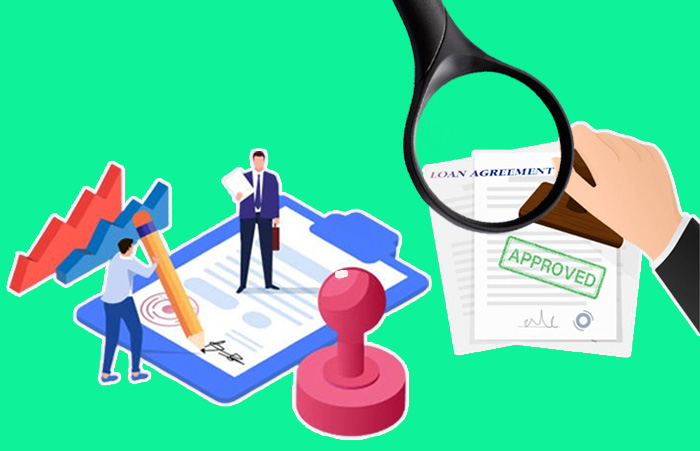So, you’ve found yourself in need of a loan. It could be for a dream car, that perfect home, or even to consolidate some existing debt. Whatever the reason, congratulations on taking the first step toward achieving your financial goals! But before you get swept up in the excitement of newfound possibilities, there’s one crucial hurdle to navigate: the loan agreement.

Loan Agreement. These lengthy documents, filled with legalese and seemingly endless clauses, can be enough to send shivers down anyone’s spine. However, resisting the urge to skim through or, worse yet, ignore the agreement altogether is a recipe for trouble. A loan agreement is, in essence, a legally binding contract that outlines the terms and conditions of borrowing money from a lender. It details everything from the loan amount and interest rate to the repayment schedule and potential consequences of default.
This might sound counterintuitive, but taking the time to decipher the fine print of a loan agreement puts you in the driver’s seat. By thoroughly grasping the details, you can:
- Make informed decisions: A clear understanding of the interest rate, fees, and repayment structure allows you to compare different loan options and choose the one that best suits your financial situation.
- Avoid hidden surprises: Loan agreements can sometimes contain clauses that outline prepayment penalties or limitations on using the borrowed funds. Knowing about these beforehand can help you avoid any unexpected costs or restrictions.
- Protect your rights and responsibilities: The agreement defines your obligations as a borrower and the lender’s commitment to providing the loan. This clarity helps prevent misunderstandings and ensures a fair and transparent transaction for all parties involved.
So, let’s turn that frown upside down and transform this seemingly intimidating document into your key to a successful borrowing experience.
What is a Loan Agreement?
A loan agreement, also known as a loan contract, is a legally binding document that formalizes the terms and conditions of a loan between a borrower (you) and a lender (bank, credit union, etc.). It clearly outlines the rights and responsibilities of both parties, ensuring everyone is on the same page throughout the borrowing process.
Key Elements:
- Loan Parties: This section identifies the borrower and lender by name, including any co-borrowers.
- Loan Amount: This indicates the precise sum of money that is being borrowed.
- Interest Rate and Fees: The agreement details the interest rate you’ll be charged on the loan, along with any associated fees like origination charges or prepayment penalties.
- Repayment Schedule: This section outlines the specific terms of repayment, including the frequency of payments (monthly, bi-weekly, etc.), the total duration of the loan (term), and the minimum amount due each time. An amortization schedule might also be included, which breaks down how much of each payment goes towards principal and interest over time.
- Collateral (if applicable): For secured loans, the agreement will identify the specific asset pledged as collateral (e.g., car for an auto loan, house for a mortgage) in case of default.
- Default Provisions: This section outlines what happens if you fail to make your loan payments as agreed. It may specify late fees, the possibility of the lender repossessing collateral, or other consequences.
- Guarantees (if applicable): In some cases, a loan agreement might involve a guarantor who agrees to repay the loan if the borrower defaults.
Remember: Loan agreements can vary depending on the type of loan and lender. It’s important to read the document carefully, understand all the terms, and ask questions if anything is unclear. Don’t hesitate to seek legal counsel if needed, especially for complex loan agreements.
Why is a Loan Agreement Important?
Money can be a touchy subject, especially regarding borrowing and lending. While a handshake deal might seem sufficient between friends or family, a formal loan agreement is crucial for securing a smooth financial transaction and protecting both the borrower and the lender. Let’s explore why a loan agreement is your financial safety net, outlining the key benefits for both parties involved.
Benefits for Borrowers:
- Clarity and Transparency: A loan agreement spells out everything in black and white. This includes the loan amount, interest rate, repayment schedule, and any late fees or prepayment penalties. This clear picture allows you, the borrower, to manage your finances effectively and avoid surprises.
- Protection from Misunderstandings: Life can get complicated, and memories can fade. A loan agreement serves as a documented record of the agreed-upon terms, eliminating any room for confusion or disagreements later on. This can be especially helpful in situations where friends or family are involved, keeping the financial aspect separate from the personal relationship.
- Improved Creditworthiness: Having a history of successfully fulfilling loan agreements with documented repayment can positively impact your credit score. This can be beneficial when applying for future loans, potentially leading to better interest rates and loan terms.
- Legal Repercussions for Unfair Practices: A well-drafted loan agreement can safeguard you from predatory lending practices. The agreement should outline the rights and responsibilities of both parties, ensuring the lender adheres to fair lending guidelines.
Benefits for Lenders:
- Security: A loan agreement offers lenders a feeling of assurance. The documented terms ensure a clear understanding of the repayment expectations and provide legal recourse in case of default. This allows lenders to make informed decisions about extending credit.
- Streamlined Collections Process: In the unfortunate event of a borrower defaulting on the loan, a comprehensive loan agreement simplifies the collections process. The documented terms serve as clear evidence in court, facilitating the recovery of funds.
- Reduced Risk of Loss: Loan agreements can mitigate the risk of loss for lenders by outlining potential consequences for late payments or defaults. This can include late fees or the possibility of repossessing collateral (if applicable).
- Professional Approach: A formal loan agreement establishes a professional tone for the lending arrangement. This can be particularly important for business loans or loans between acquaintances, helping to maintain a clear boundary between the financial transaction and the personal relationship.
Understanding Key Clauses in a Loan Agreement
it’s crucial to understand the loan agreement you’re about to sign. This legally binding document outlines the terms and conditions of your loan, and overlooking key clauses can lead to unexpected consequences down the road.
- Loan Amount & Repayment Schedule: This is the bread and butter of the agreement. It specifies the exact amount you’re borrowing, the interest rate (fixed or variable), and the repayment schedule. Pay close attention to the repayment term (total length of the loan) and the monthly payment amount. Make sure your budget can easily accommodate the repayments.
- Default & Consequences: A critical clause that defines what constitutes a default (missing a payment, for example) and the lender’s recourse in such a situation. This might include late fees, penalties, or even repossession of collateral (if it’s a secured loan). Understanding the consequences of default empowers you to prioritize your repayments and avoid a financial spiral.
- Prepayment: This clause outlines whether you’re allowed to pay off the loan early and if there are any associated penalties. While prepayment can save you money on interest in the long run, some lenders might charge a prepayment fee.
- Fees & Charges: Loan agreements often include a variety of fees like origination fees, processing fees, and even annual maintenance charges. A keen eye on this section ensures you understand the total cost of the loan beyond the headline interest rate.
- Collateral & Security Interest: Secured loans require collateral, an asset the lender can seize if you default. This clause details the specific collateral used and the lender’s rights to it.
- Dispute Resolution: This clause outlines the process for resolving disagreements between you and the lender. It might specify mediation or arbitration as alternatives to costly litigation.
Tips for Negotiating Your Loan Agreement
So, how do you ensure you’re getting the best possible deal? Here are some expert tips to strengthen your negotiation game and secure a loan agreement that works for you:
1. Knowledge is Power: Research and Understand the Landscape
Negotiation thrives on information. Before diving into discussions, invest time in researching typical loan terms for your loan type (e.g., mortgage, auto loan, personal loan). Resources like government websites, industry publications, and even competitor loan offers from banks and credit unions can provide valuable benchmarks.
Understanding the standard interest rates, fees, and repayment structures empowers you to identify areas for negotiation.
2. Leverage Your Strengths:
The stronger your financial profile, the more leverage you have at the negotiating table. Gather documents that showcase your creditworthiness, such as recent pay stubs, tax returns, and proof of a healthy credit score.
A strong credit score indicates a history of responsible borrowing and repayment, making you a less risky proposition for the lender. You can use this to negotiate for a lower interest rate or more favorable loan terms.
3. Be Specific and Confident: Ask for What You Want
Once you’ve identified specific terms you’d like to negotiate (e.g., a lower interest rate, extended repayment period, waived origination fees), approach the conversation with confidence and clarity.
Explain your rationale – for example, highlight your consistent on-time payments on past loans or an upcoming salary increase that strengthens your repayment ability.
4. Be Prepared to Walk Away: Know Your Alternatives
Negotiation is a two-way street. While compromise is ideal, it’s crucial to have a walk-away point if the lender isn’t budging on essential terms. Having explored loan options from other lenders beforehand empowers you to politely decline an unfavorable agreement and pursue a better deal elsewhere.
5. Get it All in Writing: Secure a Documented Agreement
Once you’ve reached a mutually agreeable set of terms, ensure everything is documented in writing. The finalized loan agreement should clearly outline the negotiated interest rate, fees, repayment schedule, and any other concessions made by the lender.
Review the document thoroughly before signing, ensuring all agreed-upon terms are accurately reflected.
Conclusion
Understanding a loan agreement isn’t just about ticking a box. This legally binding document outlines the exact terms of your loan, impacting how much you pay when you pay it, and what happens if things go south.
With knowledge of the key elements and potential pitfalls, remember, that knowledge is power, especially when it comes to your hard-earned money.
Don’t hesitate to ask questions about any unclear clauses or terms. Negotiate where possible, especially interest rates or repayment schedules. If the agreement feels overly complex or you have lingering doubts, seek help from a financial advisor or lawyer. A professional can provide an objective analysis and ensure you fully grasp the implications before signing on the dotted line.
Taking charge of your loan agreement is the first step towards responsible borrowing and financial security.
Empower yourself further! Check out these resources for additional information on loan agreements and financial literacy:
- The National Foundation for Credit Counseling (https://www.nfcc.org/how-we-help/) offers free resources and educational materials on various loan types and their agreements.
- The Consumer Financial Protection Bureau (https://www.consumerfinance.gov/) provides a wealth of information on loan agreements, including guides and templates.
- The American Bar Association (https://www.americanbar.org/) can help you find a qualified lawyer specializing in financial matters if you’re considering legal assistance.

